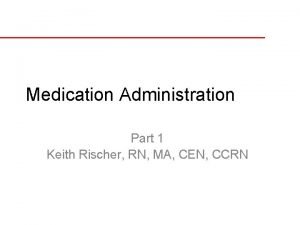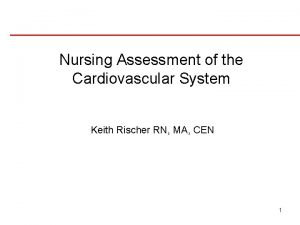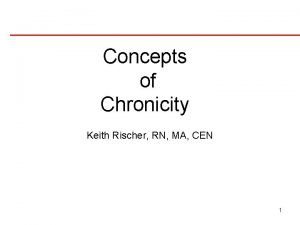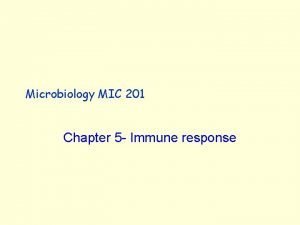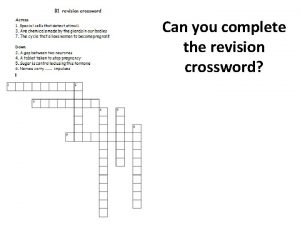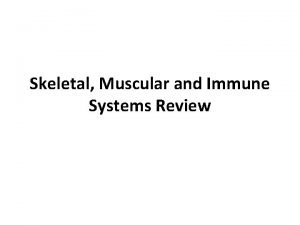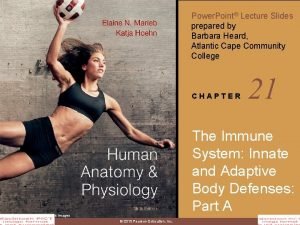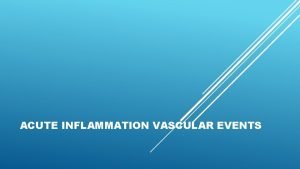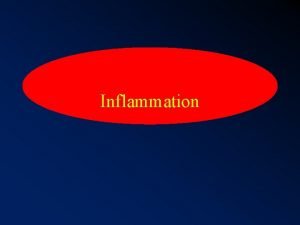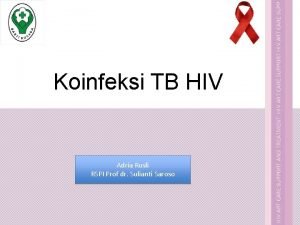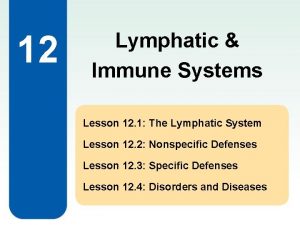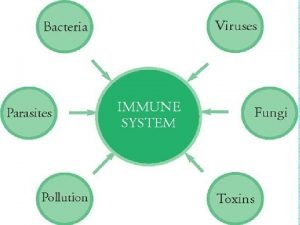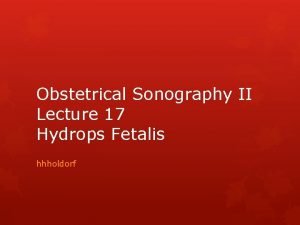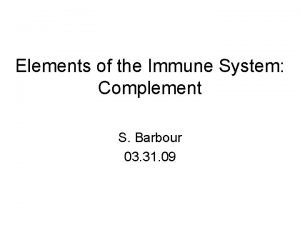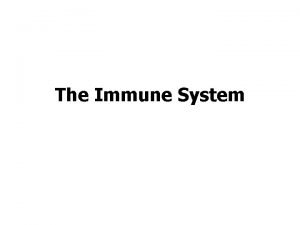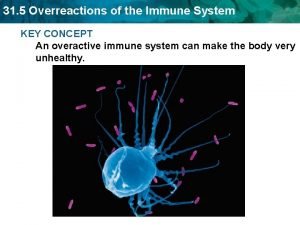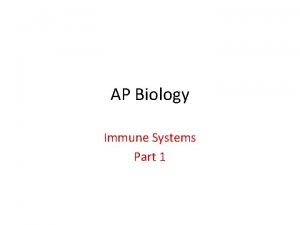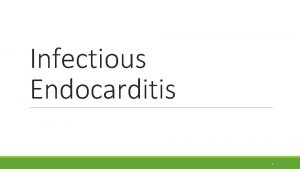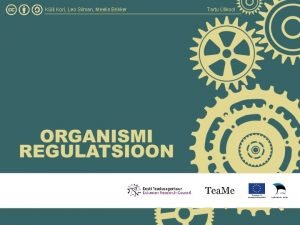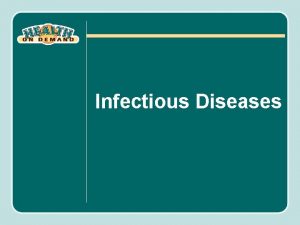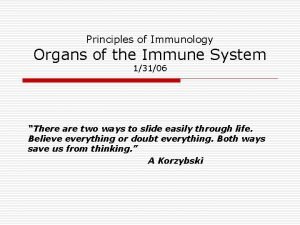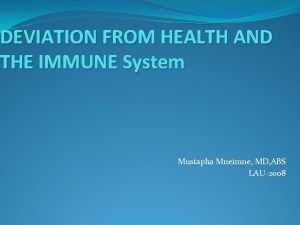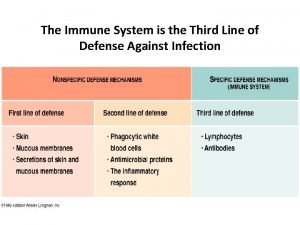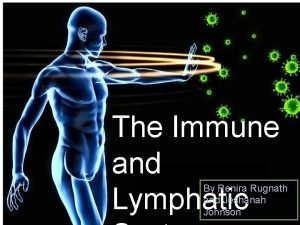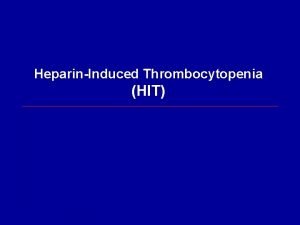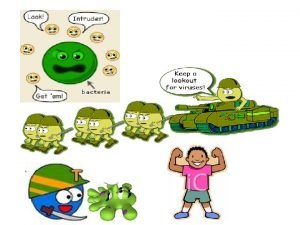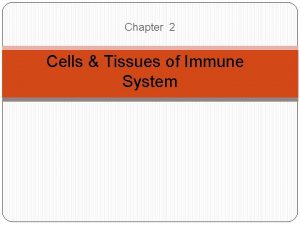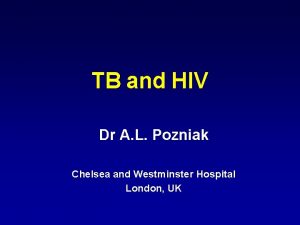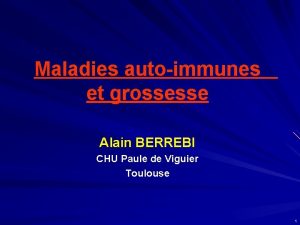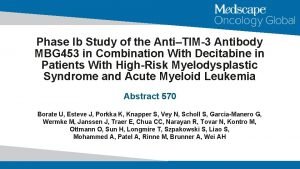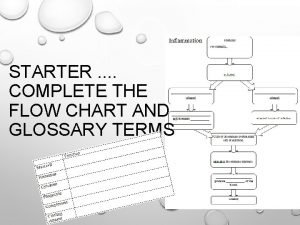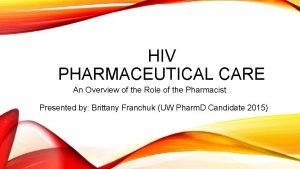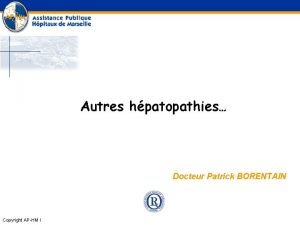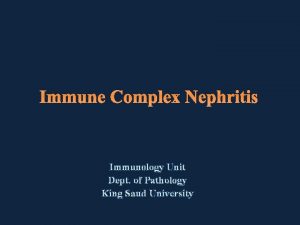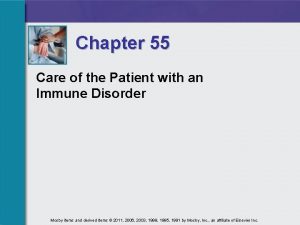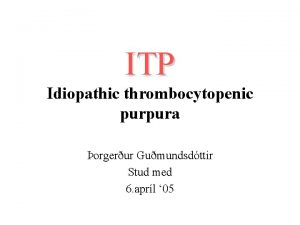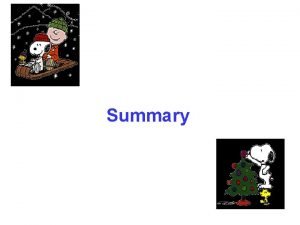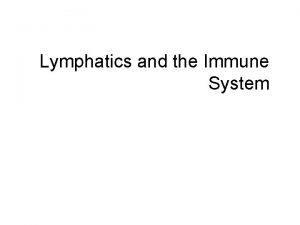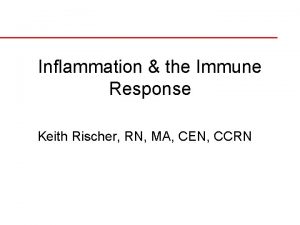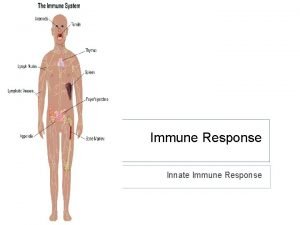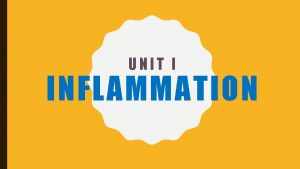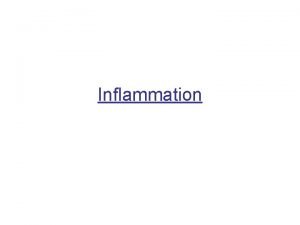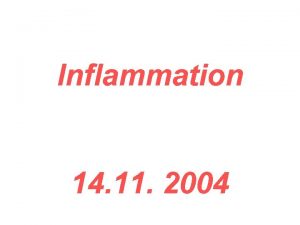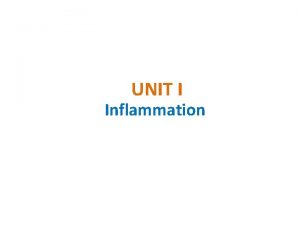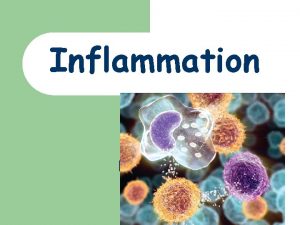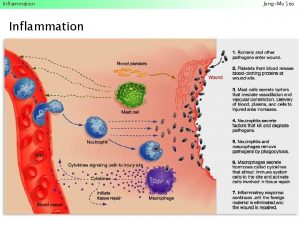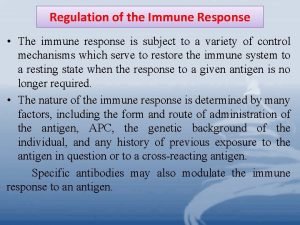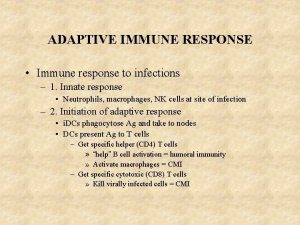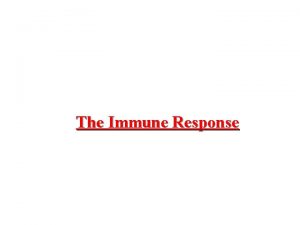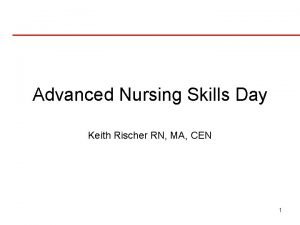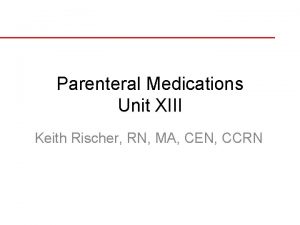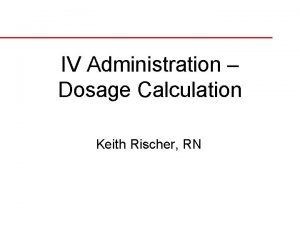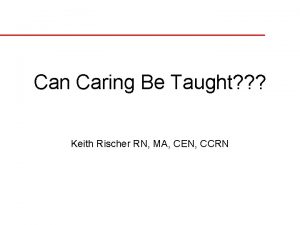Inflammation the Immune Response Keith Rischer RN MA



































































- Slides: 67

Inflammation & the Immune Response Keith Rischer, RN, MA, CEN, CCRN

Objectives for this content Ø Inflammatory response q #1 -3 Ø Infection/sepsis/chain of infection q #4 -10 Ø Physiologic immune response q #11 -16

Three Lines of Defense Anatomical Barriers Ø Acute Inflammatory Response Ø Immune System Ø

Anatomical Barriers: First Line of Defense Skin Ø Mucous membranes Ø q Normal bacterial flora ü ü Clostridium difficile Yeast infections

Normal Body Defenses Ø Skin q multilayer barrier, shed outer layer, contains fatty acids that kills some bacteria Ø Lungs q contain cilia in upper respiratory tract, macrophages Ø Urinary Tract q flush Ø action of urine washes away bacteria Perry and Potter pg. 647 Ch 34 Table 34 -3

Inflammatory Response

Inflammatory Response Occurs in response to injury Ø Localized Ø Immediate Ø Beneficial Ø Appropriate level of response Ø Non Specific Ø

Causes of Inflammation Ø Physical q Trauma q Lacerations q Burns Ø Chemical- Bites q Allergic Ø response Micro-organisms q Bacteria

Inflammatory Response REDNESS Ø SWELLING Ø PAIN Ø HEAT Ø LOSS OF FUNCTION Ø

Purpose of inflammation Neutralizes and Dilutes Toxins Ø Removes necrotic materials Ø Provides an environment for healing Ø Add “itis” to affected body part Ø

4 Phases of Inflammation Ø Vascular q Ø Think blood vessels Cellular q Think Ø Formation of Exudate q Fluid Ø WBC’s & neutrophils Healing q regeneration of tissue or repair

Vascular Phase: Blood Vessels Ø Ø Ø Injury occurs Mediators intervene Vasodilation occurs Capillaries become more permeable Swelling and movement of fluid occurs

Cellular Phase – Think WBC’s Injury occurs Ø Chemotaxis begins Ø White blood cells rush in to help Ø q Neutrophils q Monocytes q Macrophages

Chemical Mediators Coordinators of the inflammatory response Ø Histamine Ø Prostagladins Ø Cytokines

Laboratory tests Ø Erythrocyte sedimentation rate q (ESR or sed rate) q <20 mm/hr Ø CRP – C reactive protein q non specific test identifying the presence of inflammation q <1. 0 mg/dl

Nursing Diagnosis Acute pain related to tissue trauma Ø Impaired physical mobility related to discomfort Ø

Nursing Interventions Ø Care will vary with causative agent and physical condition of the patient Ø What are some nursing actions you might implement or anticipate Ø How will you as the nurse evaluate the outcome

Expected Outcomes… Healing of the wound or injury Ø Prevent minor infections from becoming overwhelming to the body Ø q UTI vs. urosepsis Goals and outcomes will vary with each patient Ø Remember that your outcomes will drive your interventions/cares Ø

Systemic Manifestations of Acute Inflammation Ø Fever/chills q Cytokines q Benefits ü Increased killing of microorganisms ü Increased phagocytosis by neutrophils ü Increased activity of interferon Ø Leukocytosis q Neutrophils q “left shift”…band cells

Medications: NSAIDS Ø Ibuprofen, Toradol q Mechanism ü Inhibits q Nursing ü Give of action prostaglandin synthesis implications w/food ü Elderly-high risk GI bleed ü Prolongs bleeding times 1 day ü Assess renal function-creatinine w/chronic use

Medications: NSAIDS Ø Salicylates – Aspirin q Mechanism of action ü Inhibits production of prostaglandins ü Decreases platelet aggregation q Nursing ü Give implications w/food ü Prolongs bleeding times 4 -7 days

Medications: Anti-histamines q Benadryl, Ranitidine (Zantec), Famotidine (Pepcid) ü Mechanism of action – Block histamine at the receptor site – Decreases gastric acid secretion ü Nursing implications – With meals – Drowsiness/dizziness

Medications: Corticosteroids Ø Prednisone q Mechanism of action ü ü q Decrease inflammation by stabilizing neutrophils and lysosomes Inhibit prostaglandin synthesis Inhibits chemotactic cytokines Decreases mast cell stimulation Nursing implications ü ü Meals Chronic use complications – Risk of infection – Hyperglycemia – SE

Normal Course of an Infection Incubation period Ø Prodromal stage Ø Full stage of illness Ø Convalescence Ø

Infectious agents/pathogens Ø Ø Bacteria Virus Fungi Protozoa

Bacteria Ø Ø Ø Single cell Human cells vs. bacteria count in body Gram +/-

Virus Ø Ø Most common affliction of humans Has no metabolism of it’s own Is incapable of replicating outside a living cell Takes over the metabolic machinery of host cells to survive and replicate

What influences Pathogen survival? Ø Ø Ø Food/Glucose Water Oxygen – aerobic/anaerobic Temperature p. H light

Reservoir Ø A place where a pathogen can survive but may or may not multiply Ø What is the most common reservoir? Ø What is a carrier?

Portal of exit Ø For the pathogen to cause an infection it must exit the reservoir Ø How can this happen?

Mode of Transmission Ø Direct or indirect Ø What is the major mode of transmission in the health care setting? Ø List the 4 categories of transmission

Portal of entry

Susceptible Host Ø What factors increase our susceptibility to infection? Age q Stress q Nutritional status q Current medical therapies q ü ü q Chemo Steroids Presence of disease

Leukocytes Ø Normal Blood Count of all WBC: 4, 000 -11, 000/ul q q q Neutrophils Monocytes Lymphocytes B cells: mediate the humoral immune response ü Ø T cells: Mediate cellular immunity Elderly considerations

Laboratory Studies Ø CBC q Hgb (12 -16 g/dl) q Hct (33 -51%) q Platelets (140 -440 thou/cu mm) q WBC (4. 5 -11. 0 thou/cu mm) Ø Differential q Never-neutrophils (42 -72%) q Let-lymphocytes (20 -44%) q Monkeys-monocytes (<11. 1%) q Eat-eosinophils (<7. 1%) q Bananas-basophils (<3. 0%)

Cultures, gram stains and sensitivities Ø Wound and skin cultures, body fluids, blood cultures Ø Gram stains Ø Sensitivities

Anti-infective Drugs Ø Determine if hypersensitive to medication Ø Check for interactions with other drugs Ø Educational needs of client Ø Determining effectiveness

Antibiotic Therapy Ø Anti-fungal q Ø Cephalosporins q Ø Amoxicillin, Ampicillin Sulfonamides q Ø Cephalexin (Keflex) Penicillins q Ø Fluconazole, Nystatin Bactrim Tetracyclines q Doxycycline

Antibiotic Resistance Ø Bacteria adapt in ways which make an antibiotic less effective or ineffective q MRSA – Methicillin resistant staphylococcus aureus q VRE – Vancomycin resistant enteroccus

Vancomycin Anti-infective class other Ø Effective against gram+ pathogens Ø Used in potentially life-threatening infections when other drugs are not effective Ø Action: binds to bacterial cell wall and cell death results Ø Poorly absorbed in GI tract, may be given IV Ø

NCLEX Concepts of Emphasis 1. Define inflammation 2. Is inflammation always present with infection? 3. What are some patient examples that would limit or impair their inflammatory response? 4. What are the five physical manifestations of the inflammatory response? 5. Name each distinct phase of the inflammatory response and unique characteristics of each? 6. What are other causes of inflammation besides microorganisms? 7. What are some common diseases of chronic inflammation? 8. What are the medications that treat the inflammatory response?

Sepsis Ø Patho Infection (susceptible host) q Inflammation-systemic q ü SIRS Capillary permeability q Vasodilation q Ø Progressive Sepsis/SIRS q Septic shock q Multiple Organ Dysfunction Syndrome (MODS) q

Article Case Study Ø Ø 70 yr female from NH CC: q weakness, diarrhea x 3 weeks Assessment: q PMH: IDDM, HTN, CVA, COPD, UTI’s q VS: T-97… 101. 8 P-109 R 20 -24 BP-93/41 91 -98% q a/o x 3 Labs: q WBC-26. 5 q Gluc 258

Article Case Study-Day 2 T-96. 6 P-125 R-24 BP 80/43 Ø Oriented to self only Ø u/o 180 cc over 8 hours Ø Became more lethargic later in day Ø T-96. 5 P-100 R-24 BP 70/30 Ø Labs Ø q WBC 41. 9 q Lactate 2. 2

Article Case Study-Day 3 T-96. 5 P-100 R 14 -32 BP 70/50 Ø Labs Ø q WBC 41. 9 q Creatinine 4. 3 Vasoactive gtts Ø Intubated Ø Died day 7 Ø

Key Nursing Assessments Ø Ø Fever/chills q Hypothermia Altered LOC/confusion Break in skin integrity q Foley catheter q Wound or incision Tachycardia q HR >100 ü What if elderly or on beta blockers?

Key Nursing Assessments Ø Ø Tachypnea q RR >20 Hypotension q SBP <90 q SBP drop of >20 -30 mm/Hg Decreasing urine output…<30 cc/hr Ø Labs q WBC q Neutrophils q Creatinine

Nursing Diagnosis statements w/infection/sepsis? Ineffective breathing pattern Ø Decreased cardiac output Ø Ineffective tissue perfusion…manifested by: Ø q Altered mental status q Behaviorial changes (restlessness) q Renal…creatinine Ø Acute confusion

NCLEX Concepts of Emphasis 1. 2. 3. 4. Why is the older adult at risk for infection and cancer development? Inflammation and immunity are provided primarily through what body cells? Differentiate the 5 types of leukocytes and what each type does to protect the body from micro-organisms Which leukocyte is elevated in bacterial infection? 1. 5. 6. 7. Why… What body cell is able to recognize and destroy nonself cells? What vital sign changes are seen in sepsis? What assessment findings are seen in sepsis?

Immune Response Passive Acquired Immunity Ø Present at birth q Short lived q Body needs to develop own Active Acquired Immunity Ø Ø After birth Active q Long-term q Exposure to microorganisms q immunizations

What comprises the immune system? v. Bone Marrow v. WBC v. Lymph system v. Thymus v. Misc: Gland Tonsils, Spleen, Mucosa, Appendix

Lymphocytes WBC that allow the body to remember and recognize previous invaders. Ø Two types Ø q. B lymphocytes q T lymphocytes. Ø NK or natural killer cells

Specific Defenses Humoral (circulating) immunity Ø Reside in B lymphocytes Ø Mediated by antibodies (immunoglobulin) produced in B cell Ø Produce antibodies when activated Cell-mediated defenses Ø T –cells released when exposure to an antigen occurs Ø 70 -80% total lymphocytes

Antigens Ø Ø An antigen is a substance that elicits an immune response Mostly comprised of protein A foreign substance that invades the body is called an antigen All cells have antigen unique to that individual allowing the body to recognize itself

Humoral (antibody) Immunity Ø Antibody mediated immunity Ø Antibodies are produced by B cells Ø Antibodies can bind to antigens Ø Immunoglobulins (Ig. G, Ig. A, Ig. M, Ig. D, Ig. E)

Cell Mediated Ø T-cells able to recognize infected cells q Cytotoxic q Ø Natural killer cell

Cytokines Ø Soluble, hormone-like protein produced by white blood cells q Ø Ø act as a messengers between cells Stimulate or inhibit the growth and activity of various immune cells Can be beneficial or harmful

Antipyretics Ø Acetaminophen Ø Ibuprofen Ø Aspirin

Immunopathology Alterations in Immunity and Inflammation q Hypersensitivity q Autoimmunity

Hypersensitivity Immediate q Allergy q Anaphylaxis Delayed q Poison Ivy q Mantoux Test

Hypersensitivity Nursing Assessment Think ABC’s q How fast is the allergic response? q How serious? q What to ask the patient? q Is this an allergic response or drug side effect? q

Name that response… Ø Baby is crying continually and pulling at her ear. Mom is frantic. Ø Young man- ate shellfish and then went to play tennis. Now is having difficulty breathing. Ø Young woman went hiking in the woods last week & now has hives present and is scratching. Ø 12 year old girl crying and shaking, holding her very swollen arm/elbow - injured playing baseball

Autoimmunity Recognizes self antigens as foreign Ø Produces antibodies against own tissue Ø Examples Ø q Lupus q Rheumatoid Arthritis

How do immunizations work? Ø The exposure (usually injection) to a small amt of virus triggers an immune response q Ø Help body prepare antibodies Type of immunity q Active artificial

NCLEX Concepts of Emphasis 1. 2. 3. 4. 5. 6. What are the similarities and differences between cellular and humoral immunity? How do vaccinations work? To be fully immune requires which three essential components of the inflammation/immune response? What is the mechanism of Prednisone and the nursing considerations when giving? What is the difference between an allergic reaction and side effect of a medication? What is the similarities & differences between hypersensitivity and anaphylactic reaction?

Bronchospasm associated with hypersensitivity reaction is the result of: A. histamine release Ø B. pulmonary ventilation Ø C. dilation of the alveoli Ø D. inadequate antibody production Ø

Which symptom indicates a possible allergic reaction? A. fever Ø B. diaphoresis Ø C. rash Ø D. chills Ø
 A subsequent
A subsequent Keith rischer
Keith rischer Keith rischer
Keith rischer Right sided heart failure
Right sided heart failure Keith rischer
Keith rischer Primary immune response
Primary immune response Passive vs active immunity
Passive vs active immunity Difference between innate and learned behavior
Difference between innate and learned behavior Immune response controller crossword
Immune response controller crossword Type of muscle
Type of muscle 1st 2nd and 3rd line of defense immune system
1st 2nd and 3rd line of defense immune system Primary and secondary immune response
Primary and secondary immune response Third line of defense immune system
Third line of defense immune system Biosimilar study
Biosimilar study Vascular response in acute inflammation
Vascular response in acute inflammation Sequelae of acute inflammation
Sequelae of acute inflammation First order system transfer function
First order system transfer function Natural and forced response
Natural and forced response Dr adria rusli
Dr adria rusli Lesson 12 blood and immune system
Lesson 12 blood and immune system 1what's the purpose of the body's immune system?
1what's the purpose of the body's immune system? Spalding sign
Spalding sign Mac immune system
Mac immune system Antigen defintion
Antigen defintion Overreactions of the immune system
Overreactions of the immune system Ap biology immune system
Ap biology immune system Immune complex
Immune complex Thymus
Thymus Defination of tuberculosis
Defination of tuberculosis Cancer vaccines
Cancer vaccines Immune system lymph nodes
Immune system lymph nodes Innate immunity first line of defense
Innate immunity first line of defense Immune system structure
Immune system structure Ctl
Ctl What is the first line of defense
What is the first line of defense Lymphatic vs immune system
Lymphatic vs immune system Chapter 24 the immune and lymphatic systems and cancer
Chapter 24 the immune and lymphatic systems and cancer What is the third line of defense in the immune system
What is the third line of defense in the immune system Hit heparin
Hit heparin Immunity assignment slideshare
Immunity assignment slideshare Immune effector cells
Immune effector cells Immune reconstitution inflammatory syndrome
Immune reconstitution inflammatory syndrome Types of antigen
Types of antigen Chapter 35 immune system and disease
Chapter 35 immune system and disease Maladie auto immune connectivite
Maladie auto immune connectivite Adaptive immunity
Adaptive immunity Malt tonsils
Malt tonsils Mbg453
Mbg453 Lesson 12 blood and immune system
Lesson 12 blood and immune system Hlab53
Hlab53 Blood cells flow chart
Blood cells flow chart Immune reconstitution therapy
Immune reconstitution therapy Hepatite auto immune fmc
Hepatite auto immune fmc Immune complex glomerulonephritis
Immune complex glomerulonephritis Chapter 55 care of the patient with an immune disorder
Chapter 55 care of the patient with an immune disorder Immune thrombocytopenic purpura
Immune thrombocytopenic purpura Main function of the immune system
Main function of the immune system The lymphatic capillaries are
The lymphatic capillaries are Lymph return
Lymph return Các châu lục và đại dương trên thế giới
Các châu lục và đại dương trên thế giới Bổ thể
Bổ thể Từ ngữ thể hiện lòng nhân hậu
Từ ngữ thể hiện lòng nhân hậu Diễn thế sinh thái là
Diễn thế sinh thái là Tư thế ngồi viết
Tư thế ngồi viết Thế nào là giọng cùng tên
Thế nào là giọng cùng tên Phép trừ bù
Phép trừ bù Thể thơ truyền thống
Thể thơ truyền thống Hát lên người ơi alleluia
Hát lên người ơi alleluia

